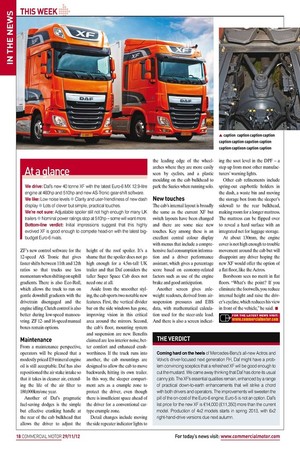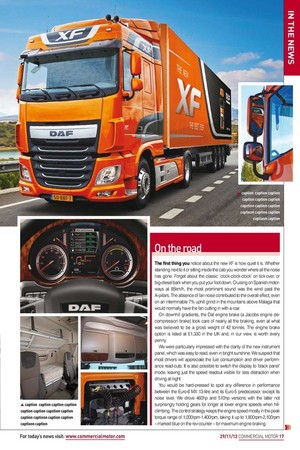The quiet
Page 11

Page 14

Page 13

If you've noticed an error in this article please click here to report it so we can fix it.
Daf says the new XF is its best yet. That’s hardly surprising – but what’s changed? CM tests it out on Spain’s mountainous roads and has the answer
Words: Brian Weatherley and David Wilcox
DAF AND MERCEDES-BENZ are neck and neck at the head of the European tractor unit market, each jostling for the number one position.
The similarities end there. Mercedes’ strategy is to wow operators with the impressive Actros, a clean-sheet design with new engines and an alluringly elegant cab. Daf, on the other hand, has chosen evolution rather than revolution and believes an updated version of its XF105 will be capable of fending off the challenge of the Actros, the new Volvo FH et al when Euro-6 takes full effect at the end of next year.
Although the new XF looks discernibly different from the current model, there is no escaping the fact the Daf has squeezed out yet another iteration of a cab shell that dates back to 1987.
Speaking at the XF press launch in Spain last week, Daf director for product development Ron Borsboom denied that this strategy was dictated by the thrift of Daf’s US parent Paccar. “We took a clean sheet of paper and drew what would be the ideal cab. It was remarkably close to what we already had,” said Borsboom. “Refining the concept is more important than being new.” But Daf has changed many of the less-obvious major components. That includes the chassis, which now has main rails that flare outwards at the front to accommodate a wider radiator. That was needed to increase engine cooling capacity to deal with the higher level of heat rejection, now that the 12.9-litre MX engine has EGR as well as SCR to meet Euro-6 NOx limits. There are also new axles and suspension, front and rear. They are designed to suit the 2.55m overall width limit rather than the previous 2.5m, and are lighter than their predecessors. Daf said these and other weightsaving measures mean that a Euro-6 XF is no more than 90kg heavier than a Euro-5 model, suggesting that some rivals have put on almost 300kg.
Despite the increased back pressure of an exhaust after-treatment system that now includes a diesel particulate filter (DPF), Daf is sure that fuel consumption will be every bit as good as that on the latest ATe versions of the Euro-5 XF.
Nominal power and torque ratings are identical to those at Euro-5: 410hp and 2,000Nm; 460hp and 2,300Nm; 510hp and 2,500Nm. Peak torque is from 1,000rpm to 1,425rpm. The main changes to the MX engine are the adoption of common-rail fuel injection (pressurised by a pair of camshaft-driven pumps) and a Cummins Holset variable geometry turbocharger.
Fuel savings
Daf has combed every nook and cranny in search of fuel savings. For example, the radiator’s surface area is now more than 30% bigger and so, despite the extra cooling required, the fan is engaged for only half the time that it is at Euro-5, saving energy.
We expected Daf to be the first customer for ZF’s new Traxion automated gearbox, the successor to the AS Tronic (CM 19 July). But Borsboom said Daf will not take the Traxion until it has been on a weight-reduction programme.
Instead, Daf is the first to use ZF’s new control software for the the leading edge of the wheelarches where they are more easily seen by cyclists, and a plastic moulding on the cab bulkhead to park the Suzies when running solo.
New touches
The cab’s internal layout is broadly the same as the current XF but switch layouts have been changed and there are some nice new touches. Key among these is an excellent central colour display with menus that include a comprehensive fuel consumption information and a driver performance assistant, which gives a percentage score based on economy-related factors such as use of the engine brake and good anticipation.
Another screen gives axleweight readouts, derived from airsuspension pressures and EBS data, with mathematical calculation used for the steer-axle load. And there is also a screen indicat ing the soot level in the DPF – a step up from most other manufacturers’ warning lights.
Other cab refinements include spring-out cup/bottle holders in the dash, a waste bin and moving the storage box from the sleeper’s sidewall to the rear bulkhead, making room for a longer mattress. The mattress can be flipped over to reveal a hard surface with an integrated net for luggage storage.
At about 130mm, the engine cover is not high enough to trouble movement around the cab but will disappoint any driver hoping the new XF would offer the option of a flat floor, like the Actros.
Borsboom sees no merit in flat floors. “What’s the point? If you eliminate the footwells, you reduce internal height and raise the driver’s eyeline, which reduces his view in front of the vehicle,” he said. ■
On the road
The first thing you notice about the new XF is how quiet it is. Whether standing next to it or sitting inside the cab you wonder where all the noise has gone. Forget about the classic ‘clock-clock-clock’ on tick-over, or big-diesel bark when you put your foot down. Cruising on Spanish motorways at 85km/h, the most prominent sound was the wind past the A-pillars. The absence of fan noise contributed to the overall effect, even on an interminable 7% uphill grind in the mountains above Malaga that would normally have the fan cutting in with a roar.
On downhill gradients, the Daf engine brake (a Jacobs engine decompression brake) took care of nearly all the braking, even at what was believed to be a gross weight of 42 tonnes. The engine brake option is listed at £1,330 in the UK and, in our view, is worth every penny.
We were particularly impressed with the clarity of the new instrument panel, which was easy to read, even in bright sunshine. We suspect that most drivers will appreciate the fuel consumption and driver performance read-outs. It is also possible to switch the display to ‘black panel’ mode, leaving just the speed readout visible for less distraction when driving at night.
You would be hard-pressed to spot any difference in performance between the Euro-6 MX 13-litre and its Euro-5 predecessor, except its noise level. We drove 460hp and 510hp versions with the latter not surprisingly holding gears for longer at lower engine speeds when hillclimbing. The control strategy keeps the engine speed mostly in the peak torque range of 1,000rpm-1,400rpm, taking it up to 1,800rpm-2,100rpm – marked blue on the rev-counter – for maximum engine braking.
At a glance
We drive: Daf’s new 40 tonne XF with the latest Euro-6 MX 12.9-litre engine at 460hp and 510hp and new AS-Tronic gear-shift software. We like: Low noise levels ● Clarity and user-friendliness of new dash display ● Lots of clever but simple, practical touches.
We’re not sure: Adjustable spoiler still not high enough for many UK trailers ● Nominal power ratings stop at 510hp – some will want more. Bottom-line verdict: Initial impressions suggest that this highly evolved XF is good enough to compete head-on with the latest bigbudget Euro-6 rivals.
ZF’s new control software for the 12-speed AS Tronic that gives faster shifts between 11th and 12th ratios so that trucks use less momentum when shifting on uphill gradients. There is also Eco-Roll, which allows the truck to run on gentle downhill gradients with the drivetrain disengaged and the engine idling. Clutch control is also better during low-speed manoeuvring. ZF 12and 16-speed manual boxes remain options.
Maintenance
From a maintenance perspective, operators will be pleased that a modestly priced E9 mineral engine oil is still acceptable. Daf has also repositioned the air stake intake so that it takes in cleaner air, extending the life of the air filter to 180,000km/one year.
Another of Daf’s pragmatic fuel-saving dodges is the simple but effective cranking handle at the rear of the cab bulkhead that allows the driver to adjust the height of the roof spoiler. It’s a shame that the spoiler does not go high enough for a 4.5m-tall UK trailer and that Daf considers the taller Super Space Cab does not need one at all.
Aside from the smoother styling, the cab sports two notable new features. First, the vertical divider bar on the side windows has gone, improving vision in this critical area around the mirrors. Second, the cab’s floor, mounting system and suspension are new. Benefits claimed are less interior noise, better comfort and enhanced crashworthiness. If the truck runs into another, the cab mountings are designed to allow the cab to move backwards, hitting its own trailer. In this way, the sleeper compartment acts as a crumple zone to protect the driver, even though there is insufficient space ahead of the driver for a conventional cartype crumple zone.
Detail changes include moving the side repeater indicator lights to
THE VERDICT
Coming hard on the heels of Mercedes-Benz’s all-new Actros and Volvo’s driver-focused next generation FH, Daf might have a problem convincing sceptics that a refreshed XF will be good enough to cut the mustard. We came away thinking that Daf has done its usual canny job. The XF’s essential qualities remain, enhanced by a range of practical down-to-earth enhancements that will strike a chord with both drivers and operators. The improvements will sweeten the pill of the on-cost of the Euro-6 engine; Euro-5 is not an option. Daf’s list price for the new XF is €14,000 (£11,350) more than the current model. Production of 4x2 models starts in spring 2013, with 6x2 right-hand-drive versions due next autumn.













































